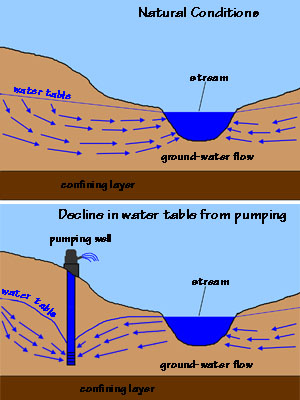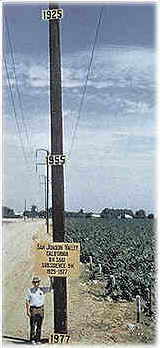| page last updated |
 |
River Tour | Estuary | Salt Marsh | |
| What is an Estuary? > Climate > Geology > Surface Water > Ground Water > Aquatic Habitat > Upland Habitat > Ecological Processes > Animals and Plants > Socioeconomic Values > Human Impacts and Pollution > Where does Your water come from? > Management Issues > Protecting YOUR Watershed | ||
|
K-12
Students Site
|
||
| Hydrology > Groundwater > Surface Water > Water Cycle | ||||||||||||
|
Hydrology is the study of water and its properties, scientific laws, and distribution. Hydrologists study surface water and groundwater (water under the ground) and their interactions, which are part of the water cycle. Did you
know? Where
is your aquifer? |
||||||||||||
 |
||||||||||||
|
Aquifers are very important. In many areas they are our main source of freshwater. In order to get water from an aquifer, we drill a well and pump the water to the surface. The water in aquifers is valuable because it is relatively clean. Soil cleans and filters rainwater as it seeps through the earth. Soil absorbs many chemical compounds and waste. Most aquifers lie deep under the ground. Some are small and provide water to a only few homes. Some are so big they spread across a few states! For example, the Floridan aquifer is so large it crosses Mississippi, Alabama, Georgia, Florida, and South Carolina! (See map of Floridan aquifer.) The Floridan aquifer is the main source of freshwater for people living in the Coastal Plain region of the Altamaha River watershed (see map of Geological Regions). Freshwater in the Piedmont region is supplied by surface water (for more information on water sources see Where does YOUR water come from?). The table
you can't eat off of The depth of a water table may go up and down. Rainfall raises the water table. Pumping water from wells lowers it. To find your local water table, start digging. You'll know when you've found it. Groundwater will start seeping into and filling your hole. The depth of the water table is different in different places. If you dig a hole at the ocean shore, you will hit the water table within 1 m (3 feet). If you dig a hole in the desert, you will be digging a long time before you find water. In the desert, where there is little rain, the water table may be hundreds of meters (hundreds of feet) below ground! Taking
care of our aquifers Pollution Withdrawing
too much water As our need for water increases, we withdraw more and more from our aquifers. In fact, in many places we are taking it faster than nature is putting it back. This means that we are slowly emptying our aquifers. |
||||||||||||
 |
 |
|||||||||||
| This photo, which is from the USGS web site on land subsidence (http://water.wr.usgs.gov/subsidence/ls_3.html), shows where the land surface in this California field was in 1925, 1955 and 1977, when the picture was taken. | ||||||||||||
|
Serious problems arise when we drain our aquifers. Remember, aquifers are large, porous areas of rock underneath the ground. When they are not filled with water, they have trouble supporting the heavy soil layers above them. In fact, entire cities sometimes sink into the ground above depleted aquifers! In the last 100 years, central California has sunk 8 meters (26 feet). New Orleans, Louisiana, sits more than 2 meters (about 7 feet) below where it used to be. The water table is now so high in New Orleans that people are no longer buried underground! Occasionally in the past, after heavy rains, caskets would float to the surface and drift along in floodwater. Now in New Orleans people are laid to rest above ground in concrete buildings known as mausoleums. Coastal areas face another problem if aquifer water levels are reduced. Open space in an aquifer may become filled with saltwater from the ocean. Saltwater, which is lighter than freshwater, spreads rapidly throughout the bottom of the aquifer. Salt contamination of the Floridan aquifer is a growing problem along the coast of Georgia. As more and more people move to the coast and build homes and businesses, more and more water is withdrawn from the aquifer there. Saltwater from the Atlantic Ocean has already entered the aquifer. |
||||||||||||
 |
||||||||||||
| click on the diagram for a larger view | ||||||||||||
|
Finally, if we withdraw too much water, the water table may drop below the aquifer. It may be almost impossible or very expensive to pump water from so deep underground. To learn
more about our clean water supply and how to protect it, see
Human
Impacts and Pollution, and Protecting our watershed:
What YOU can do to help. |
||||||||||||